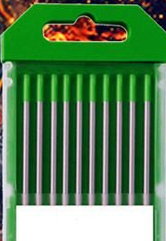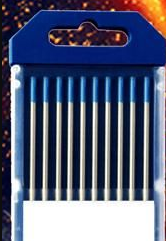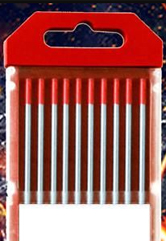Tungsten electrodes are used primarily in gas tungsten arc welding (GTAW), also known as Tungsten Inert Gas (TIG) welding. GTAW is a welding process that involves the use of a non-consumable tungsten electrode, which produces an arc that melts the metal being welded. The tungsten electrode is held in a torch, and a flow of gas (usually argon) is used to protect the weld area from atmospheric contamination.
Tungsten electrodes are used in GTAW welding because of their high melting point and excellent resistance to thermal fatigue. They are available in various diameters and lengths and are designed to produce a stable arc and reliable performance. Tungsten electrodes are also used in plasma welding and cutting, where they are employed as an electrode in a plasma torch.

Pure Tungsten Electrode
The use of tungsten electrodes is critical in GTAW welding, as the electrode's performance affects the quality of the weld. The tungsten electrode is the only part of the GTAW torch that does not melt during the welding process. The electrode must withstand high temperatures and be resistant to contamination from the metal being welded, which can cause porosity and other defects in the weld. Tungsten electrodes can be made from pure tungsten or from a tungsten alloy that contains other elements, such as thorium, cerium, or lanthanum. Each alloy has its own properties and is selected based on the specific application.
Pure tungsten electrodes are used for welding aluminum and magnesium alloys, as well as non-ferrous metals such as copper and nickel alloys. Pure tungsten electrodes are also used for welding thin sections of stainless steel and titanium, where the heat input must be carefully controlled to prevent warping and distortion. However, pure tungsten electrodes are prone to contamination from the metal being welded, which can lead to porosity and other defects in the weld.

Lanthanated Tungsten Electrode
To address this issue, tungsten electrodes are often alloyed with other elements to improve their performance. Thoriated tungsten electrodes are the most commonly used alloyed tungsten electrode. They are alloyed with thorium oxide, which improves the electrode's electron emission and makes it easier to start and maintain the arc. Thoriated tungsten electrodes are used for welding steel and stainless steel, as well as non-ferrous metals such as copper and nickel alloys. They are also used for welding thicker sections of material, where the heat input must be increased to achieve good penetration.
Ceriated tungsten electrodes are another commonly used alloyed tungsten electrode. They are alloyed with cerium oxide, which improves the electrode's arc stability and reduces the likelihood of contamination. Ceriated tungsten electrodes are used for welding steel and stainless steel, as well as non-ferrous metals such as copper and nickel alloys. They are also used for welding thin sections of material, where the heat input must be carefully controlled.

Thoriated Tungsten Electrode
Lanthanated tungsten electrodes are also used in GTAW welding. They are alloyed with lanthanum oxide, which improves the electrode's arc stability and makes it easier to start and maintain the arc. Lanthanated tungsten electrodes are used for welding steel and stainless steel, as well as non-ferrous metals such as copper and nickel alloys. They are also used for welding thicker sections of material, where the heat input must be increased to achieve good penetration.
Zirconiated tungsten electrodes are alloyed with zirconium oxide and are used primarily for welding aluminum and magnesium alloys. They are also used for welding non-ferrous metals such as copper and nickel alloys. Zirconiated tungsten electrodes produce a stable arc and are less prone to contamination than pure tungsten electrodes.










